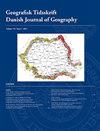Residential mobility trajectories and integration in Douala and Bafoussam, Cameroon
IF 1.1
4区 社会学
Q4 ENVIRONMENTAL STUDIES
Geografisk Tidsskrift-Danish Journal of Geography
Pub Date : 2017-07-03
DOI:10.1080/00167223.2017.1362351
引用次数: 2
Abstract
Abstract This study examines how migrant households relocate their homes in two Cameroonian cities over the course of lifetimes or even generations. The central claim is that homeownership is the ultimate sign of integration into city life. Using qualitative and quantitative research methods (218 interviews, 30 focus groups and a household survey, sample size 686), the study argues that three key factors explain why people move: the quality of housing they can affords, the proximity to a workplace and the potential for homeownership. Three residential model trajectories are identified. The first describes a journey from being a new migrant who is a guest of family or friends in the city centre to being a married family with kids owning a home in the urban periphery. The second model continues that journey by returning back to the city centre in pursuit of more convenient, high-status home location (if finances permit). A third model describes moves to sites all over the city later in life as older individuals seek to maximize family income in the way they use multiple properties. Understanding residential mobility patterns has the potential to lead to a better public policies and more effective private investments in the housing sector.喀麦隆杜阿拉和巴富萨姆的居民流动轨迹和一体化
摘要本研究考察了喀麦隆两个城市的移民家庭在一生甚至几代人的过程中如何搬迁他们的家园。其核心主张是,拥有住房是融入城市生活的最终标志。该研究采用定性和定量研究方法(218次访谈,30个焦点小组和一项家庭调查,样本量为686),认为有三个关键因素可以解释人们为什么搬家:他们能负担得起的住房质量,离工作场所的距离以及拥有住房的可能性。确定了三种居住模式轨迹。第一个描述的是一个新移民的旅程,从一个在市中心做客的家人或朋友,到一个已婚家庭,带着孩子在城市边缘拥有自己的房子。第二种模式则继续这一旅程,回到市中心,寻找更方便、地位更高的住所(如果经济状况允许的话)。第三种模式描述了老年人在晚年搬到城市各处,因为他们寻求通过使用多处房产来最大化家庭收入。了解居民流动模式有可能导致更好的公共政策和更有效的住房部门私人投资。
本文章由计算机程序翻译,如有差异,请以英文原文为准。
求助全文
约1分钟内获得全文
求助全文
来源期刊
CiteScore
5.20
自引率
0.00%
发文量
5
期刊介绍:
DJG is an interdisciplinary, international journal that publishes peer reviewed research articles on all aspects of geography. Coverage includes such topics as human geography, physical geography, human-environment interactions, Earth Observation, and Geographical Information Science. DJG also welcomes articles which address geographical perspectives of e.g. environmental studies, development studies, planning, landscape ecology and sustainability science. In addition to full-length papers, DJG publishes research notes. The journal has two annual issues. Authors from all parts of the world working within geography or related fields are invited to publish their research in the journal.

 求助内容:
求助内容: 应助结果提醒方式:
应助结果提醒方式:


